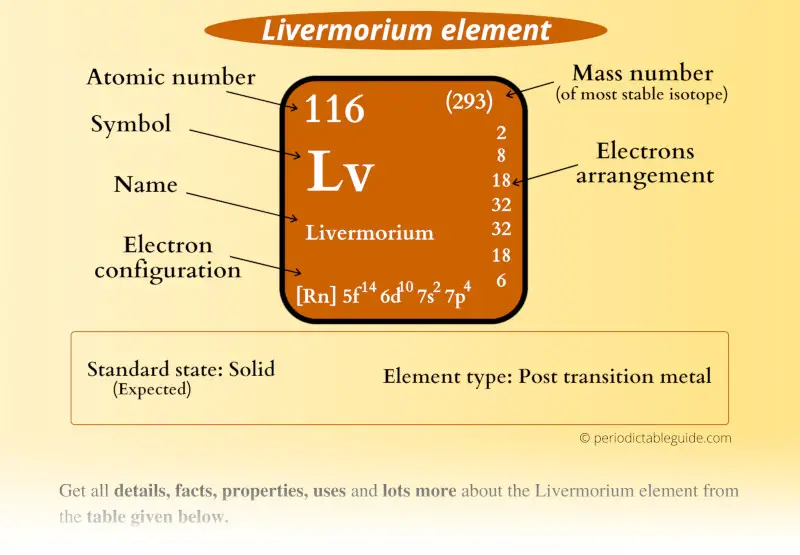
This is a SUPER easy guide on Livermorium element.
In fact, the table mentioned below is the perfect information box (Which gives you every single detail about the Livermorium element in Periodic table.)
So if you want to know anything about Livermorium element, then this guide is for you.
Let’s dive right into it!
Livermorium Element (Lv) Information
| State (at STP) | Solid (predicted) |
| Position in Periodic table | 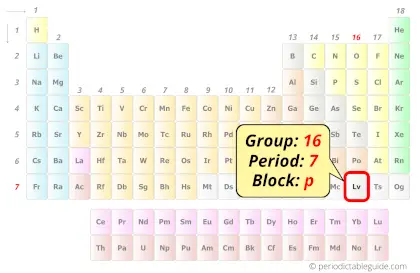 Group: 16, Period: 7, Block: p |
| Category | Synthetic element |
| Atomic number or Protons | 116 |
| Electrons | 116 |
| Symbol | Lv |
| Atomic mass (most stable isotope) | 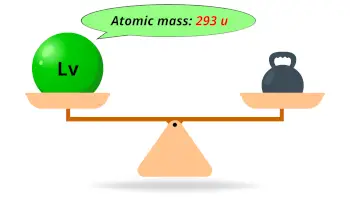 293 u |
| Electrons arrangement or Bohr model | 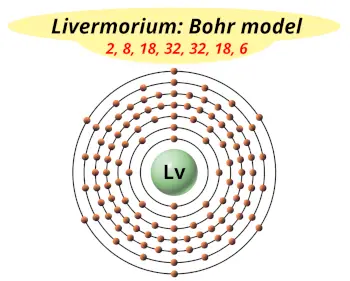 2, 8, 18, 32, 32, 18, 6 |
| Electronic configuration | [Rn] 5f14 6d10 7s2 7p4 |
| Density | 12.9 g/cm3 |
| Main isotope | 293Lv |
| CAS number | 54100-71-9 |
Livermorium in Periodic table
Livermorium element is in group 16 and period 7 of the Periodic table. Livermorium is the p-block element and it is a radioactive synthetic element.
| H | He | ||||||||||||||||
| Li | Be | B | C | N | O | F | Ne | ||||||||||
| Na | Mg | Al | Si | P | S | Cl | Ar | ||||||||||
| K | Ca | Sc | Ti | V | Cr | Mn | Fe | Co | Ni | Cu | Zn | Ga | Ge | As | Se | Br | Kr |
| Rb | Sr | Y | Zr | Nb | Mo | Tc | Ru | Rh | Pd | Ag | Cd | In | Sn | Sb | Te | I | Xe |
| Cs | Ba | La* | Hf | Ta | W | Re | Os | Ir | Pt | Au | Hg | Tl | Pb | Bi | Po | At | Rn |
| Fr | Ra | Ac** | Rf | Db | Sg | Bh | Hs | Mt | Ds | Rg | Cn | Nh | Fl | Mc | Lv | Ts | Og |
| *Ce | Pr | Nd | Pm | Sm | Eu | Gd | Tb | Dy | Ho | Er | Tm | Yb | Lu | ||||
| **Th | Pa | U | Np | Pu | Am | Cm | Bk | Cf | Es | Fm | Md | No | Lr |
←Move to: Moscovium (Mc) element – Periodic Table
→Move to: Tennessine (Ts) element – Periodic Table
Why is Livermorium in Group 16?
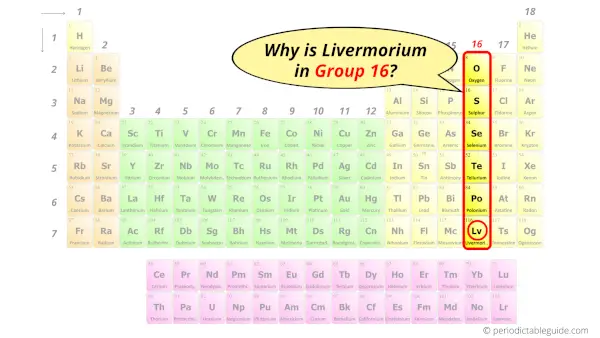
Do you know, how many electrons can be accommodated in the first shell, second shell, third shell, fourth shell, etc…?
Here is the table showing the capacity of orbits to hold electrons.
Number of electrons in shells.
| Orbit / Shell (n) | Maximum no. of electrons this orbit can hold (2 × n2) |
| K shell, n = 1 | 2 × 1² = 2 |
| L shell, n = 2 | 2 × 2² = 8 |
| M shell, n = 3 | 2 × 3² = 18 |
| N shell, n = 4 | 2 × 4² = 32 |
| . . . | . . . |
Thus,
- 1st shell can hold 2 electrons.
- 2nd shell can hold 8 electrons.
- 3rd shell can hold 18 electrons.
- 4th shell can hold 32 electrons, and so on…
Now the atomic number of Livermorium (Lv) is 116.
Hence the livermorium element has electrons arrangement 2, 8, 18, 32, 32, 18, 6.
This electron arrangement indicates that the outermost orbit of livermorium element (Lv) has 6 electrons.
Hence, it lies in group 16.
Why is Livermorium in Period 7?
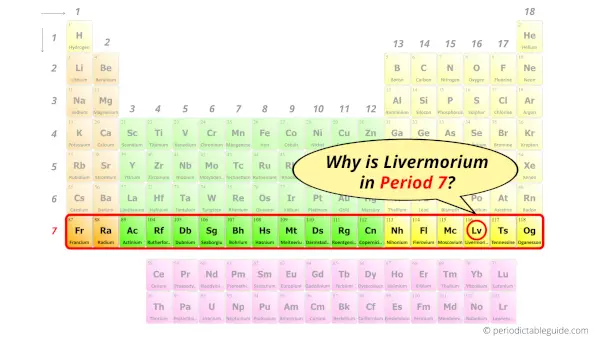
Let me ask you a question.
How many shells does a livermorium atom have?
It’s 7. Right?
You have already seen the bohr model of livermorium atom in the above table.
From the Bohr model, it can be found that the number of orbits or shells in livermorium is 7. Hence, as livermorium has 7 orbits, it lies in period 7 of the Periodic table.
5 facts about Livermorium
Interesting facts about livermorium element are mentioned below.
- The name “Livermorium” came from the name of the “Lawrence Livermore National laboratory”, which is in California.
- Livermorium was discovered by a team of scientists at Lawrence Livermore National laboratory (California), and at Joint Institute for Nuclear Research (Russia).
- Livermorium is not available naturally, but it is artificially prepared in a laboratory.
- All the isotopes of livermorium are radioactive in nature.
- Out of all the known isotopes of livermorium, the most stable isotope is 293Lv, which has a half life of 57 milliseconds.
Properties of Livermorium
The physical and chemical properties of livermorium element are mentioned below.
- Livermorium element is extremely radioactive and it has a very short half life.
- Livermorium is predicted to have solid phase at STP.
- The common oxidation state of livermorium is predicted to be +2.
- The estimated atomic mass of the most stable isotope of livermorium is 293 u and its density is predicted to be 12.9 g/cm3.
Uses of Livermorium
Livermorium is basically used for research work in chemistry. Livermorium has no commercial use due to its high radioactivity and its expensive production.
Explore our New Interactive Periodic Table (with Rotating Bohr Models and More)

Details about this Periodic table:
- Access detailed info on all elements: atomic mass, electron configurations, charges, and more.
- View rotating Bohr models for all 118 elements.
- Get a free HD image of the Periodic Table.
Note: For future use, bookmark this Periodic table or visit “PeriodicTableGuide.com”
External resources:
- Livermorium – Element information, properties and uses | Periodic Table. (n.d.). Livermorium – Element Information, Properties and Uses | Periodic Table. https://www.rsc.org/periodic-table/element/116/livermorium
- Livermorium – Wikipedia. (2013, October 4). Livermorium – Wikipedia. https://en.wikipedia.org/wiki/Livermorium
- P. (n.d.). Livermorium | Lv (Element) – PubChem. Livermorium | Lv (Element) – PubChem. https://pubchem.ncbi.nlm.nih.gov/element/Livermorium
- It’s Elemental – The Element Livermorium. (n.d.). It’s Elemental – the Element Livermorium. https://education.jlab.org/itselemental/ele116.html
- Livermorium. (n.d.). Livermorium. https://pls.llnl.gov/research-and-development/nuclear-science/project-highlights/livermorium
- Periodic Table of Elements: Los Alamos National Laboratory. (n.d.). Periodic Table of Elements: Los Alamos National Laboratory. https://periodic.lanl.gov/116.shtml
